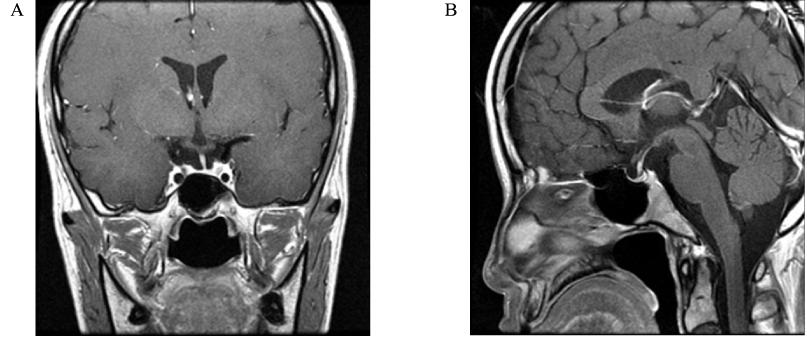J Korean Endocr Soc.
2009 Jun;24(2):121-125. 10.3803/jkes.2009.24.2.121.
Spontaneous Pregnancy and Delivery in a Patient with Sheehan's Syndrome
- Affiliations
-
- 1Department of Internal Medicine, College of Medicine, Dankook University, Korea.
- KMID: 1468507
- DOI: http://doi.org/10.3803/jkes.2009.24.2.121
Abstract
- Sheehan's syndrome is postpartum hypopituitarism due to the necrosis of the pituitary gland. It is usually the result of severe hypotension or shock caused by massive hemorrhage during or after delivery. Patients with Sheehan's syndrome have varying degrees of anterior pituitary hormone deficiency. They are accompanied with amenorrhea and ovulation dysfunction, and so they rarely get pregnant naturally. Ovulation induction is necessary if these patients desire to become pregnant. However, spontaneous pregnancy may be possible in some patients who have a preserved gonadotrophin reserve. We experienced a case of 29-year-old woman who was diagnosed Sheehan's syndrome 20 months after delivery and we medicated her with prednisolone and thyroxine. She got pregnant spontaneously after 18 months of hormone replacement therapy although she had amenorrhea and irregular menstrual cycles. She successfully delivered a baby by cesarean section. Here we report on this case with a review of the relevant literature concerned with pregnancy and Sheehan's syndrome.
MeSH Terms
Figure
Reference
-
1. Keleştimur F. Sheehan's syndrome. Pituitary. 2003. 6:181–188.2. Kovacs K. Sheehan syndrome. Lancet. 2003. 361:520–522.3. Gonzalez JG, Elizondo G, Saldivar D, Nanez H, Todd LE, Villarreal JZ. Pituitary gland growth during normal pregnancy: an in vivo study using magnetic resonance imaging. Am J Med. 1988. 85:217–220.4. Dejager S, Gerber S, Foubert L, Turpin G. Sheehan's syndrome: differential diagnosis in the acute phase. J Intern Med. 1998. 244:261–266.5. Veldhuis JD, Hammond JM. Endocrine function after spontaneous infarction of the human pituitary: report, review, and reappraisal. Endocr Rev. 1980. 1:100–107.6. Lee BK, Shin DB, Kim SW, Yang IM, Kim JW, Kim YS, Choi YK. The combined pituitary stimulation test in Sheehan's syndrome. Korean J Med. 1987. 33:36–43.7. Huang YY, Ting MK, Hsu BR, Tsai JS. Demonstration of reserved anterior pituitary function among patients with amenorrhea after postpartum hemorrhage. Gynecol Endocrinol. 2000. 14:99–104.8. Colakoğlu M, Erçal T, Karslioğlu S. Commencement of normal menstrual cycles after 17 years in a patient with Sheehan's syndrome. Am J Med. 1987. 82:578.9. See TT, Lee SP, Chen HF. Spontaneous pregnancy and partial recovery of pituitary function in a patient with Sheehan's syndrome. J Chin Med Assoc. 2005. 68:189–190.10. Algün E, Ayakta H, Harman M, Topal C, Aksoy H. Spontaneous pregnancy in a patient with Sheehan's syndrome. Eur J Obstet Gynecol Reprod Biol. 2003. 110:242–244.11. Dash RJ, Gupta V, Suri S. Sheehan's syndrome: clinical profile, pituitary hormone responses and computed sellar tomography. Aust N Z J Med. 1993. 23:26–31.12. Sheehan HL. Postpartum necrosis of the anterior pituitary. Ir J Med Sci. 1948. 19:241–255.13. Sheehan HL. Simmond's disease due to postpartum necrosis of anterior pituitary. QJM. 1939. 8:277–309.14. Gupta D, Gaiha M, Mahajan R, Daga MK. Atypical presentation of Sheehan's syndrome without postpartum haemorrhage. J Assoc Physicians India. 2001. 49:386–387.15. Zargar AH, Singh B, Laway BA, Masoodi SR, Wani AI, Bashir MI. Epidemiologic aspects of postpartum pituitary hypofunction (Sheehan's syndrome). Fertil Steril. 2005. 84:523–528.16. Feinberg EC, Molitch ME, Endres LK, Peaceman AM. The incidence of Sheehan's syndrome after obstetric hemorrhage. Fertil Steril. 2005. 84:975–979.17. Goswami R, Kochupillai N, Crock PA, Jaleel A, Gupta N. Pituitary autoimmunity in patients with Sheehan's syndrome. J Clin Endocrinol Metab. 2002. 87:4137–4141.18. Vance ML. Hypopituitarism. N Engl J Med. 1994. 330:1651–1662.19. Sert M, Tetiker T, Kirim S, Kocak M. Clinical report of 28 patients with Sheehan's syndrome. Endocr J. 2003. 50:297–301.20. Hall R, Manski-Nankervis J, Goni N, Davies MC, Conway GS. Fertility outcomes in women with hypopituitarism. Clin Endocrinol (Oxf). 2006. 65:71–74.


